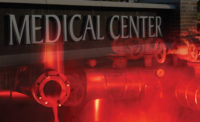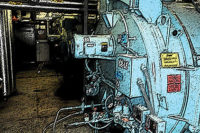According to the United States Department of Energy, motors in homes and commercial buildings consume more than one-third of all the electricity used in these buildings. Sixty-five percent of electrical energy used in commercial and industrial systems goes to support electrical motors powering centrifugal pumps and fans.
This makes the motor one of the most important components of HVAC systems. The efficiency and reliability of the HVAC system is dependent on the performance of the motor, which is the primary building block for all pumps and fans.
What are electric Motors?
Electric motors use the principles of electromagnetics to produce the torque used to rotate an axle. When current passes through a coil of wire, a magnetic field is induced perpendicular to the plane of the coil. A magnetic field produced by an electric current is called an electromagnet. This magnetic effect due to the current loop is amplified when the wire is coiled around a ferrous metal. Magnetic north poles attract magnetic south poles and repel magnetic north poles. These attractive and repulsive forces are manipulated in an electric motor to produce torque, or rotational force, on the axle.
The two most common motors in HVAC system are induction motors and synchronous motors. Induction motors are so called because voltage is induced in the rotor (thus no need for brushes), but for this to happen, the rotor must rotate at a lower speed than the magnetic field to allow for the existence of an induced voltage. This difference between the motor and the magnetic field is known as the “slip.” The most common of this type of motor is the squirrel cage motors. Primary induction motors are the most common in HVAC systems because of the low initial cost and high reliability.
Synchronous motors are so called because the rotor tries to line up with the rotating magnetic field in the stator. It has the stator of an induction motor but the rotor of a dc motor. The difference between the two motors is that the synchronous motor rotates in exact synchronism with the line frequency. This motor does not rely on the current induction to produce the rotor’s magnetic field. These types of motors are used in equipment and appliances where high-precision constant speed is required.
ECM Motors
Recent development and improvement in motor technologies have introduced the HVAC industry to a motor that is more efficient than primary induction motors, even when combined with VFDs. These motors are known as electronically commutated motors (ECM). ECM motors were formally called integrated control motors (ICM), which are electronically controlled by microprocessors.
The control module is the brains of the ECM motor. The control device converts AC power to DC power to operate the internal electronics of the motor, thus allowing the motor to act like a DC motor. The microprocessor in the control module is programmed to convert DC power to a 3-phase signal to drive the motor, which makes it a 3-phase motor. It also has the added ability to control the frequency (which controls the speed in revolutions per minute) and the amount of torque (current/power) it delivers to the motor.
Advantages of ECM Motors
ECM motors have a number of advantages when compared to induction motors. The most notable is the more efficient operation; it is approximately 50% more efficient than a comparable induction motor. Since the motor operation is controlled by microprocessor, it offers significant advantages with its operational range and accuracy. Because of this, an ECM motor is able to measure and regulate its speed and power output without the use of external sensors or controllers. The microprocessor precisely controls the magnetic field in the ECM motor, and therefore it is always synchronous, as opposed to the asynchronous induction motors. Unlike the heat loss that induction motors experience because of that lag, ECM operates at almost zero heat loss.
What about Variable Frequency Drives on an induction motor?
There exists the argument that an induction motor in a traditional fan array with a VFD is the most energy-efficient arrangement for an AHU design. This fan/VFD arrangement is viewed as the best means of ensuring that the fan is performing in the most energy-efficient manner during operation. However, it is important to note that induction motors are designed to deliver maximum efficiency at a single voltage, load, and speed, typically at their rated load and speed. Moving the motor operation off this point will reduce the motor efficiency, typically from 55-65% and possibly as low as 12-18%. It is common for an induction motor operating at its low speed to consume as much power as its rated operational point and thus offset the energy reduction intended with an attached VFD.
Where ECM motors are Commonly Used in the HVAC Industry?
ECM motors are predominantly used in the residential HVAC industry. ECMs are used in the motors for modulating furnaces, modulating boilers, condensing units, heat pumps, cooling towers, geothermal heat pumps, fancoil units, and fan powered VAV boxes. They are used in many HVAC systems with small horsepower ratings.
ECM Motors in Air handling Units
AHUs are the most common air distribution system for the HVAC industry. Figure 1 shows that cooling and ventilation accounts for 35% of the energy use in commercial buildings. For this reason, the industry should be focused on reducing this 35% by using technologies that will reduce the energy used by air distribution system. A typical AHU in the commercial industry consists of the following components: pre-filter and final filter, humidifier, heating coil, cooling coil, supply and return fans. The fans are the workhorse for the AHUs and are singularly responsible for the air delivery to every air distribution terminal in a building. The more efficient the fans are, the more energy efficient the AHU (and by extension the overall HVAC system in the building) will be.
There are several types of fans utilized in AHUs, the most common are airfoil, plug, plenum, and centrifugal. Although the efficiency of fans has been dramatically improved over the past ten years, there is still room for improvement for fan technology when it comes to efficiency.
Over the past five years, improvements in ECM technology have increased the use of ECM motors for the fans in AHUs. In the past, they were mostly used for small AHUs below 2,000 cfm. However, we are now seeing the use of ECM motors in large custom AHUs, even moreso due to the use of fan arrays in these settings.
Fan arrays are the most widely used technology in today’s AHU applications because of the better efficiencies when compared to larger centrifugal fans. Because they involve smaller cfm, the multiple-fan scenario naturally lends itself to the use of ECM motors. The use of ECM fans is on the rise because they provide much better efficiency than the most premium efficiency fan motor. There are several advantages that ECM has when compared to traditional fan array configuration, including the following.
-
Unlike a typical “fan wall or fan matrix,” fans do not need to shut off individually.
-
In the event that one fan/motor assembly should fail, the other fans in the array can simply increase output to compensate until the matter can be resolved.
-
Since the motor and drive are built into every fan, no lengthy line runs are required and thus the harmonics are greatly reduced.
-
The superior construction involving airfoil or backward-inclined fan blades with a directly coupled motor reduces turbulence and the potential for vibration, eliminates stratification, and eliminates conventional noises caused by belt and sheaves assemblies.
ECM fans also provide several other key benefits that are important for certain industries. They are compact, occupy smaller footprints, have longer operating life, have very high cfm range, and there is no VFD required for the units.
One of the most important routine maintenance responsibilities regarding AHUs involves filter replacement. The lack of proper filter maintenance is a large contributor to increased energy use in commercial buildings. One of the huge benefits of using ECM fans is that the airflow will not vary with filter loading, and therefore poor filter maintenance will not lead to additional energy use.
ECM fans are not suited for all applications. In addition to horsepower considerations, there are some limitations to the technology due to the maximum pressure drop that can be handled by ECM motors. Most ECM fans are limited to a maximum of 5 inch w.c. of external static pressure. Therefore, ECM is not suited for large applications that require high external static pressures.
Mechanical engineers should start investigating innovative ways of specifying ECM motors for large AHUs even in an application where there is high static pressure. I have implemented this strategy when designing large custom AHUs for high static pressure applications. The supply static pressure for the supply side was too high to use ECM fans, but the return fans’ pressures were low enough for its use. The ECM fan array was specified for a return section of unit, while the higher static pressure supply side was specified with normal fan array arrangement with VFD.
Conclusion
Reducing the energy consumption for commercial buildings should be the focus of the HVAC industry. Business as usual will not solve the dire situation with climate change. HVAC engineers should continue to utilize new technologies that have the potential to reduce the energy footprints of buildings. The use of ECM fans is becoming commonplace in the HVAC industry. This is encouraging because it will contribute to reducing the 35% of energy use for the ventilation and air conditioning in buildings.
The continued research into the technology will contribute to its wider application. The ECM is more expensive than the normal fan array technology, but the applications have a better lifecycle cost than the traditional fan array configuration. ECM fans are the future of fan array technology for both small- and large-scale AHU applications.






